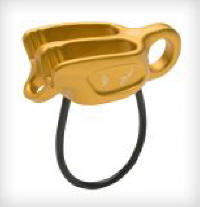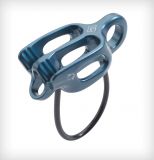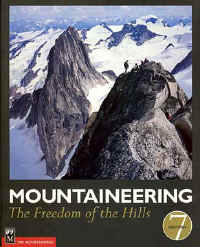 ™
™TRADITIONAL MOUNTAINEERING
™
www.TraditionalMountaineering.org
™ and also
www.AlpineMountaineering.org
™
 ™
™
FREE BASIC TO ADVANCED
ALPINE MOUNTAIN CLIMBING INSTRUCTION™
Home
| Information
| Photos
| Calendar
| News
| Seminars
| Experiences
| Questions
| Updates
| Books
| Conditions
| Links
| Search
![]()
What is the best belay | rappel | autoblock device for traditional alpine mountaineering?
Click on an image you like to see the full version; broadband folks can click
here to see the full sized page
The best belay, rappel and autoblock device to have on your Alpine Bod Harness may be the new Trango B52. (Or is the best the Black Diamond ATC-Guide?) This is why I think so and so!
In 1971, Royal Robbins, in his landmark book "Basic Rockcraft", describes only the "body belay" where the belayer's body, braced in the correct position and perhaps anchored, provided the necessary friction for a dynamic belay of the lead or following climber who was tied into the rope by a bowline on a coil or a swami belt alone. Rappels described by Robbins were the dulfersitz or long rappels controlled by a "brake" assembled from six to eight oval carabiners with gates opposed. The traditional mountaineer at least knows and has practiced the super easy, super fast body belays. I never had to use the clumsy carabiner brake.
By 1973, Royal Robbins published "Advanced Rockcraft" including a chapter titled "Gadgets". Robbins wrote "Although I personally prefer climbing methods that are spare, there are climbers (and the number is growing) who see advantages in equipment not strictly necessary". The Gadgets Robbins described were Safety Helmets, Seat and Chest Harnesses, Descenders (the figure eight) and the Sticht Belay Plate.
Some folks still use the figure eight descender or rappel device. It is best suited for larger ropes (10 to 11 mm), and can be dangerous with smaller diameter alpine ropes (7.6 to 9 mm) because the amount of friction can not be controlled. Suggested use of the small end as a belay device is very questionable.
The Sticht belay plate can be found in second hand stores and on the racks of some very old climbers. Some (the Sticht plates not the old climbers) were equipped with a coiled spring wire to keep the carabiner away from the plate so the rope could be paid out more easily. I have always found the Sticht plate hard to use. It is either on, (jammed) or off. (A nifty use is to place the plate (sans spring) in front of the anchor pulley in a crevasse rescue to serve as a prussic block.)
A few years ago, Trango offered the Pyramid. It was designed both for belaying and for rappelling. Black Diamond produced a similar device a few months later that they called the Air Traffic Controller or ATC. The Trango Pyramid is a little easier to push a too fat rope into and could be used in two modes, providing two degrees of friction. The Trango Pyramid has fins which can dissipate rappelling heat better than the ATC, according to popular belief. I think most mountaineers prefer the Trango Pyramid over the ATC.
Both the ATC and the Trango Pyramid loose friction on the smaller diameter 7.6 to 8.9 mm alpine ropes. Trango did a novel comparison test of the braking force required by several devices. There is no standard for this test, but field reports seem to support their findings according to Malcolm Daley. The Trango Pyramid required 24.7 pounds of force for a 10.7mm rope and 36.9 for an 8.4mm rope. The ATC required 22.3 and 36.7 pounds of force.
Petzl offered the Grigri. Sport climbers take note: do not bring your Grigri to the mountains. The Petzl tech notes state: "The Grigri is designed for indoor climbing or sport climbing, NOT for alpinism or adventure climbing. The Grigri is NOT a substitute for skilled, vigilant belaying!" The Grigri is designed as an automatic rope lock in the event of a fall. This lock action may rip sketchy alpine anchors from the "not necessarily perfect" alpine rock, snow or ice.
Now Trango has produced the B-52! It is much
lighter (60g) and more simple than the Reverso. It weighs 60gm and the Reverso
weighs 81gm. It looks more like the ATC or
Trango Pyramid, but the advanced design makes it easier to load the rope
through long slots and easier to feed rope to the leader. It is a
very smooth rappel device for ropes from 8 to 11mm. The B52 will also
function as an autoblock with a locking carabiner from your SARENE anchor clipped
through the long slot that takes the upper belay rope. (The
alloy body of the B52 reportedly tested very strong in this configuration. It was
tested on an Enstron dynamometer and reportedly the carabiner broke before the
B52.) The Trango
test showed the B52 required 19.2 pounds of force for a 10.7mm rope and only
23.2 for an 8.4mm rope, very important for the traditional mountaineer.
The B52 retails for about $23.00! It's bomber!
--Robert Speik
Copyright© 2004-2011 by Robert Speik. All rights reserved.
Well, time passes and the World Turns: the BD ATC-Guide
I just received my new BD ATC-Guide "Full Function Belay and Rappel Device" direct from Black Diamond Equipment. The BD ATC-Guide device certainly looks less tricky to use than the B-52!
Here is an illustration of the BD ATC-Guide so you can compare:


The link below leads to the second generation of the BD ATC-Guide (with lightening holes). I now own both BD ATC-Guides!
http://www.blackdiamondequipment.com/en-us/shop/climb/belay-rappel/atc-guide-belay-rappel-device
Follow the link above for the real, big picture! Check out the video for how to safely use this device!
Here are the three most obvious improvements
over of the BD ATC-Guide (102g) over the Trango B-52 (60g) that we can note:
There is a very big and stout looking hole to link the ATC-Guide
device to the anchor (not your harness!) when using it in the Guide mode. I will
do this infrequently. I am not a Guide. But in a rescue situation, it might
be great to have a self stopping system to belay a companion downclimbing a pitch, etc.
Note that the above is a perceived improvement
over the B-52, which requires clipping a carabiner through the (strong) "frame" of the little device.
There is an obvious handy little hole at the other side, to ease or release the grip of the device on the rope(s) when used in guide mode. Move this by hand or with your handy prussic cord using a biner on the anchor as a pulley to re-direct the releasing pull to your harness biner.
Here is the best improvement, in our opinion:
The BD ATC-Guide has two little slots on a narrowed section that grips each side
of the rope(s) when used in the "HFM" (High Friction Mode). Used in the "RFM"
(Regular Friction Mode) the device works like the old reliable BD ATC.
OK, Bob, what is so good about this?
Well, traditional mountaineers use skinny (light weight) ropes. The BD ATC-Guide
will hold a belay or rappel or follower on rope diameters from 7.7mm to 11mm, single or
double. So will the Trango B52 but I think the ATC-Guide is harder to mis-use.
It looks like the BD ATC-Guide device may hold skinny ropes better than the B-52, due to the little slots in the narrower profile. I will try to find out if tests have been made.
However, the ATC-Guide is 1.41801327 ounces heavier than the B52!
(The ATC-XP and the ATC-Sport both have these
little slots in a narrower profile and can be used in the HFM mode. The ATC-Sport is really for single
rope top-rope belays only.)
--Robert Speik
Copyright© 2011 by Robert Speik. All rights reserved.
![]()
![]()
![]() WARNING - *DISCLAIMER!*
WARNING - *DISCLAIMER!*
Mountain climbing has inherent dangers that can in part, be mitigated

South Sister, Middle Sister, North Sister (the sinister sister) and Broken Top in the Three Sisters Wilderness near Bend, Oregon USA
Photo Copyright© 2004 - 2011 by Robert Speik. All rights reserved.
Read more:
Warning!
Here are links to the manufacturers instructions for this
gear. The notes above are only meant to point you in the right direction.
Read the manufacturers instructions. Do your own research and learn to use your
gear with an experienced person, practicing techniques on belay at the local
crag with friends before lugging it up the hill to attempt a technical peak.
--Webmeister.
Trango B52
Black Diamond ATC-Guide
TECHNICAL MOUNTAINEERING
What is the best traditional alpine mountaineering summit pack?
What is the best belay | rappel | autoblock device for traditional alpine mountaineering?
What gear do you normally rack on your traditional alpine mountaineering harness?
Photos?
![]()
What is the best traditional alpine mountaineering seat harness?
Photos?
Can I use a Sharpie Pen for Marking the Middle of the Climbing Rope?
What are the highest peaks in Oregon?
Alphabetically?
YOUR ESSENTIAL SUMMIT PACK
What are the new Ten Essential Systems?
What does experience tell us about Light and Fast climbing?
What is the best traditional alpine mountaineering summit pack?
What is Light and Fast alpine climbing?
What do you carry in your day pack?
Photos?
![]()
What do you carry in your winter day pack?
Photos?
![]()
What should I know about "space blankets"?
Where can I get a personal and a group first aid kit?
Photos?
YOUR LITE AND FAST BACKPACK
Which light backpack do you use for winter and summer?
Analysis
pdf
![]()
What would you carry in your backpack to climb Shasta or Adams?
![]()
What is the best traditional alpine mountaineering summit pack?
Photos of lite gear packed for a multi day approach to spring and summer summits
Backpack lite gear list for spring and summer alpine mountaineering
4 pdf pages
ESSENTIAL PERSONAL GEAR
What does Steve House wear for light and fast climbing?
What clothing do you wear for Light and Fast winter mountaineering?
What do you carry in your winter day pack?
Photos?
![]()
Which digital camera do you use in the mountains?
What about Boots and Shoes?
![]()
TRADITIONAL KNOWLEDGE
How did you become interested in traditional mountaineering techniques?
Who is Conrad Messner?
What is traditional slacklining or highlining?
What are some of the comments you have received?
Who was Peter Starr?
Who are the Mazamas?
What is an avalanche cord?
Who were the notorious Vulgarians?
How was top rope climbing practiced in the 1970s?
What is a Whillans sit harness?
What is a dulfersitz rappel?
How do I self-belay a rappel? ![]()

Read about belaying and rappelling in the eighth edition of this book!